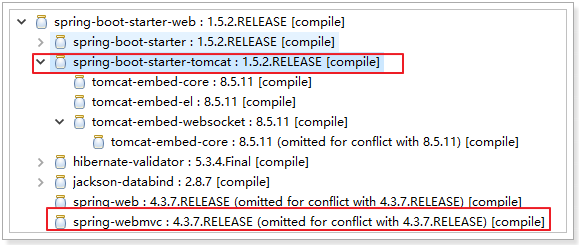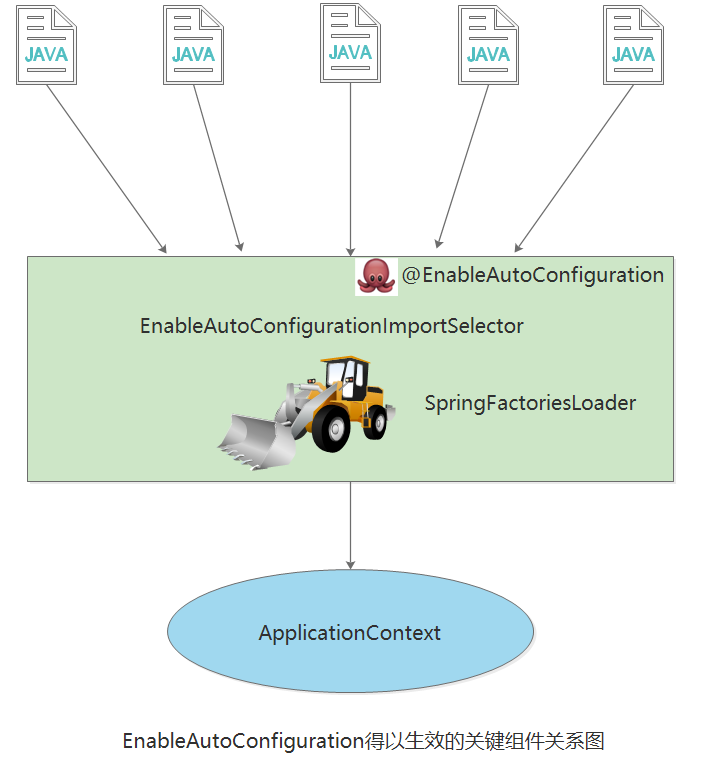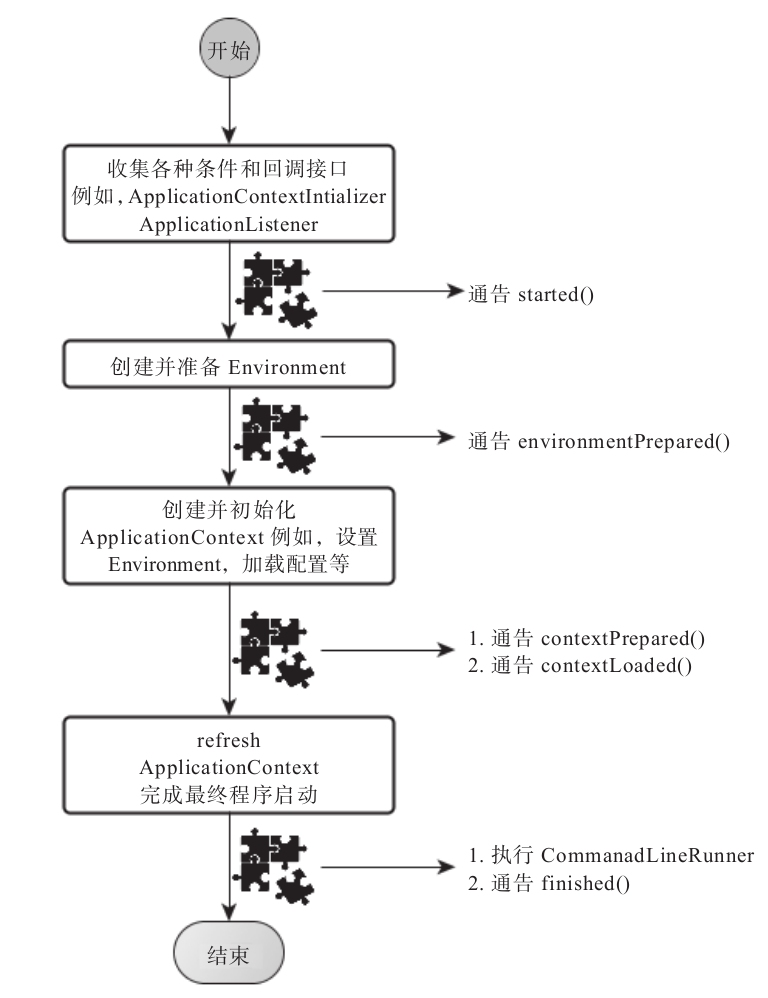springboot啟動原理及原始碼賞析
springboot啟動原理剖析
2019年8月1日
15:42
我們開發任何一個Spring Boot專案,都會用到如下的啟動類
1 @SpringBootApplication 2 public class Application { 3 public static void main(String[] args) { 4 SpringApplication.run(Application.class, args); 5 } 6 }
從上面程式碼可以看出,Annotation定義(@SpringBootApplication)和類定義(SpringApplication.run)最為耀眼,所以要揭開SpringBoot的神祕面紗,我們要從這兩位開始就可以了。
一、SpringBootApplication背後的祕密
@SpringBootApplication註解是Spring Boot的核心註解,它其實是一個組合註解:
1 @Target(ElementType.TYPE) 2 @Retention(RetentionPolicy.RUNTIME) 3 @Documented 4 @Inherited 5 @SpringBootConfiguration 6 @EnableAutoConfiguration 7 @ComponentScan(excludeFilters = { 8 @Filter(type = FilterType.CUSTOM, classes = TypeExcludeFilter.class), 9 @Filter(type = FilterType.CUSTOM, classes = AutoConfigurationExcludeFilter.class) }) 10 public @interface SpringBootApplication { 11 ... 12 }
雖然定義使用了多個Annotation進行了原資訊標註,但實際上重要的只有三個Annotation:
- @Configuration(@SpringBootConfiguration點開檢視發現裡面還是應用了@Configuration)
- @EnableAutoConfiguration
- @ComponentScan
即 @SpringBootApplication = (預設屬性)@Configuration + @EnableAutoConfiguration + @ComponentScan。
所以,如果我們使用如下的SpringBoot啟動類,整個
1 @Configuration
2 @EnableAutoConfiguration
3 @ComponentScan
4 public class Application {
5 public static void main(String[] args) {
6 SpringApplication.run(Application.class, args);
7 }
8 }
每次寫這3個比較累,所以寫一個@SpringBootApplication方便點。接下來分別介紹這3個Annotation。
1、@Configuration
這裡的@Configuration對我們來說不陌生,它就是JavaConfig形式的Spring Ioc容器的配置類使用的那個@Configuration,SpringBoot社群推薦使用基於JavaConfig的配置形式,所以,這裡的啟動類標註了@Configuration之後,本身其實也是一個IoC容器的配置類。
舉幾個簡單例子回顧下,XML跟config配置方式的區別:
(1)表達形式層面
基於XML配置的方式是這樣:
1 <?xml version="1.0" encoding="UTF-8"?>
2 <beans xmlns="http://www.springframework.org/schema/beans"
3 xmlns:xsi="http://www.w3.org/2001/XMLSchema-instance"
4 xsi:schemaLocation="http://www.springframework.org/schema/beans http://www.springframework.org/schema/beans/spring-beans-3.0.xsd"
5 default-lazy-init="true">
6 <!--bean定義-->
7 </beans>而基於JavaConfig的配置方式是這樣:
1 @Configuration
2 public class MockConfiguration{
3 //bean定義
4 }任何一個標註了@Configuration的Java類定義都是一個JavaConfig配置類。
(2)註冊bean定義層面
基於XML的配置形式是這樣:
1 <bean id="mockService" class="..MockServiceImpl">
2 ...
3 </bean>而基於JavaConfig的配置形式是這樣的:
1 @Configuration
2 public class MockConfiguration{
3 @Bean
4 public MockService mockService(){
5 return new MockServiceImpl();
6 }
7 }
任何一個標註了@Bean的方法,其返回值將作為一個bean定義註冊到Spring的IoC容器,方法名將預設成該bean定義的id。
(3)表達依賴注入關係層面
為了表達bean與bean之間的依賴關係,在XML形式中一般是這樣:
1 <bean id="mockService" class="..MockServiceImpl">
2 <propery name ="dependencyService" ref="dependencyService" />
3 </bean>
4
5 <bean id="dependencyService" class="DependencyServiceImpl"></bean>而基於JavaConfig的配置形式是這樣的:
1 @Configuration
2 public class MockConfiguration{
3 @Bean
4 public MockService mockService(){
5 return new MockServiceImpl(dependencyService());
6 }
7
8 @Bean
9 public DependencyService dependencyService(){
10 return new DependencyServiceImpl();
11 }
12 }
如果一個bean的定義依賴其他bean,則直接呼叫對應的JavaConfig類中依賴bean的建立方法就可以了。
@Configuration:提到@Configuration就要提到他的搭檔@Bean。使用這兩個註解就可以建立一個簡單的spring配置類,可以用來替代相應的xml配置檔案。
1 <beans>
2 <bean id = "car" class="com.test.Car">
3 <property name="wheel" ref = "wheel"></property>
4 </bean>
5 <bean id = "wheel" class="com.test.Wheel"></bean>
6 </beans>相當於:
1 @Configuration
2 public class Conf {
3 @Bean
4 public Car car() {
5 Car car = new Car();
6 car.setWheel(wheel());
7 return car;
8 }
9
10 @Bean
11 public Wheel wheel() {
12 return new Wheel();
13 }
14 }
@Configuration的註解類標識這個類可以使用Spring IoC容器作為bean定義的來源。
@Bean註解告訴Spring,一個帶有@Bean的註解方法將返回一個物件,該物件應該被註冊為在Spring應用程式上下文中的bean。
2、@ComponentScan
@ComponentScan這個註解在Spring中很重要,它對應XML配置中的元素,@ComponentScan的功能其實就是自動掃描並載入符合條件的元件(比如@Component和@Repository等)或者bean定義,最終將這些bean定義載入到IoC容器中。
我們可以通過basePackages等屬性來細粒度的定製@ComponentScan自動掃描的範圍,如果不指定,則預設Spring框架實現會從宣告@ComponentScan所在類的package進行掃描。
注:所以SpringBoot的啟動類最好是放在root package下,因為預設不指定basePackages。
3、@EnableAutoConfiguration
個人感覺@EnableAutoConfiguration這個Annotation最為重要,所以放在最後來解讀,大家是否還記得Spring框架提供的各種名字為@Enable開頭的Annotation定義?比如@EnableScheduling、@EnableCaching、@EnableMBeanExport等,@EnableAutoConfiguration的理念和做事方式其實一脈相承,簡單概括一下就是,藉助@Import的支援,收集和註冊特定場景相關的bean定義。
- @EnableScheduling是通過@Import將Spring排程框架相關的bean定義都載入到IoC容器。
- @EnableMBeanExport是通過@Import將JMX相關的bean定義載入到IoC容器。
而@EnableAutoConfiguration也是藉助@Import的幫助,將所有符合自動配置條件的bean定義載入到IoC容器,僅此而已!
@EnableAutoConfiguration會根據類路徑中的jar依賴為專案進行自動配置,如:添加了spring-boot-starter-web依賴,會自動新增Tomcat和Spring MVC的依賴,Spring Boot會對Tomcat和Spring MVC進行自動配置。

@EnableAutoConfiguration作為一個複合Annotation,其自身定義關鍵資訊如下:
1 @SuppressWarnings("deprecation")
2 @Target(ElementType.TYPE)
3 @Retention(RetentionPolicy.RUNTIME)
4 @Documented
5 @Inherited
6 @AutoConfigurationPackage
7 @Import(EnableAutoConfigurationImportSelector.class)
8 public @interface EnableAutoConfiguration {
9 ...
10 }
其中,最關鍵的要屬@Import(EnableAutoConfigurationImportSelector.class),藉助EnableAutoConfigurationImportSelector,@EnableAutoConfiguration可以幫助SpringBoot應用將所有符合條件的@Configuration配置都載入到當前SpringBoot建立並使用的IoC容器。就像一隻“八爪魚”一樣,藉助於Spring框架原有的一個工具類:SpringFactoriesLoader的支援,@EnableAutoConfiguration可以智慧的自動配置功效才得以大功告成!

自動配置幕後英雄:SpringFactoriesLoader詳解
SpringFactoriesLoader屬於Spring框架私有的一種擴充套件方案,其主要功能就是從指定的配置檔案META-INF/spring.factories載入配置。
1 public abstract class SpringFactoriesLoader {
2 //...
3 public static <T> List<T> loadFactories(Class<T> factoryClass, ClassLoader classLoader) {
4 ...
5 }
6
7
8 public static List<String> loadFactoryNames(Class<?> factoryClass, ClassLoader classLoader) {
9 ....
10 }
11 }
配合@EnableAutoConfiguration使用的話,它更多是提供一種配置查詢的功能支援,即根據@EnableAutoConfiguration的完整類名org.springframework.boot.autoconfigure.EnableAutoConfiguration作為查詢的Key,獲取對應的一組@Configuration類。

上圖就是從SpringBoot的autoconfigure依賴包中的META-INF/spring.factories配置檔案中摘錄的一段內容,可以很好地說明問題。
所以,@EnableAutoConfiguration自動配置的魔法騎士就變成了:從classpath中搜尋所有的META-INF/spring.factories配置檔案,並將其中org.springframework.boot.autoconfigure.EnableutoConfiguration對應的配置項通過反射(Java Refletion)例項化為對應的標註了@Configuration的JavaConfig形式的IoC容器配置類,然後彙總為一個並載入到IoC容器。
二、深入探索SpringApplication執行流程
SpringApplication的run方法的實現是我們本次旅程的主要線路,該方法的主要流程大體可以歸納如下:
1) 如果我們使用的是SpringApplication的靜態run方法,那麼,這個方法裡面首先要建立一個SpringApplication物件例項,然後呼叫這個建立好的SpringApplication的例項方法。在SpringApplication例項初始化的時候,它會提前做幾件事情:
- 根據classpath裡面是否存在某個特徵類(org.springframework.web.context.ConfigurableWebApplicationContext)來決定是否應該建立一個為Web應用使用的ApplicationContext型別。
- 使用SpringFactoriesLoader在應用的classpath中查詢並載入所有可用的ApplicationContextInitializer。
- 使用SpringFactoriesLoader在應用的classpath中查詢並載入所有可用的ApplicationListener。
- 推斷並設定main方法的定義類。
2) SpringApplication例項初始化完成並且完成設定後,就開始執行run方法的邏輯了,方法執行伊始,首先遍歷執行所有通過SpringFactoriesLoader可以查詢到並載入的SpringApplicationRunListener。呼叫它們的started()方法,告訴這些SpringApplicationRunListener,“嘿,SpringBoot應用要開始執行咯!”。
3) 建立並配置當前Spring Boot應用將要使用的Environment(包括配置要使用的PropertySource以及Profile)。
4) 遍歷呼叫所有SpringApplicationRunListener的environmentPrepared()的方法,告訴他們:“當前SpringBoot應用使用的Environment準備好了咯!”。
5) 如果SpringApplication的showBanner屬性被設定為true,則列印banner。
6) 根據使用者是否明確設定了applicationContextClass型別以及初始化階段的推斷結果,決定該為當前SpringBoot應用建立什麼型別的ApplicationContext並建立完成,然後根據條件決定是否新增ShutdownHook,決定是否使用自定義的BeanNameGenerator,決定是否使用自定義的ResourceLoader,當然,最重要的,將之前準備好的Environment設定給建立好的ApplicationContext使用。
7) ApplicationContext建立好之後,SpringApplication會再次藉助Spring-FactoriesLoader,查詢並載入classpath中所有可用的ApplicationContext-Initializer,然後遍歷呼叫這些ApplicationContextInitializer的initialize(applicationContext)方法來對已經建立好的ApplicationContext進行進一步的處理。
8) 遍歷呼叫所有SpringApplicationRunListener的contextPrepared()方法。
9) 最核心的一步,將之前通過@EnableAutoConfiguration獲取的所有配置以及其他形式的IoC容器配置載入到已經準備完畢的ApplicationContext。
10) 遍歷呼叫所有SpringApplicationRunListener的contextLoaded()方法。
11) 呼叫ApplicationContext的refresh()方法,完成IoC容器可用的最後一道工序。
12) 查詢當前ApplicationContext中是否註冊有CommandLineRunner,如果有,則遍歷執行它們。
13) 正常情況下,遍歷執行SpringApplicationRunListener的finished()方法、(如果整個過程出現異常,則依然呼叫所有SpringApplicationRunListener的finished()方法,只不過這種情況下會將異常資訊一併傳入處理)
去除事件通知點後,整個流程如下:

本文以除錯一個實際的SpringBoot啟動程式為例,參考流程中主要類類圖,來分析其啟動邏輯和自動化配置原理。

總覽:
上圖為SpringBoot啟動結構圖,我們發現啟動流程主要分為三個部分,第一部分進行SpringApplication的初始化模組,配置一些基本的環境變數、資源、構造器、監聽器,第二部分實現了應用具體的啟動方案,包括啟動流程的監聽模組、載入配置環境模組、及核心的建立上下文環境模組,第三部分是自動化配置模組,該模組作為springboot自動配置核心,在後面的分析中會詳細討論。在下面的啟動程式中我們會串聯起結構中的主要功能。
啟動:
每個SpringBoot程式都有一個主入口,也就是main方法,main裡面呼叫SpringApplication.run()啟動整個spring-boot程式,該方法所在類需要使用@SpringBootApplication註解,以及@ImportResource註解(if need),@SpringBootApplication包括三個註解,功能如下:
@EnableAutoConfiguration:SpringBoot根據應用所宣告的依賴來對Spring框架進行自動配置。
@SpringBootConfiguration(內部為@Configuration):被標註的類等於在spring的XML配置檔案中(applicationContext.xml),裝配所有bean事務,提供了一個spring的上下文環境。
@ComponentScan:元件掃描,可自動發現和裝配Bean,預設掃描SpringApplication的run方法裡的Booter.class所在的包路徑下檔案,所以最好將該啟動類放到根包路徑下。

SpringBoot啟動類
首先進入run方法
